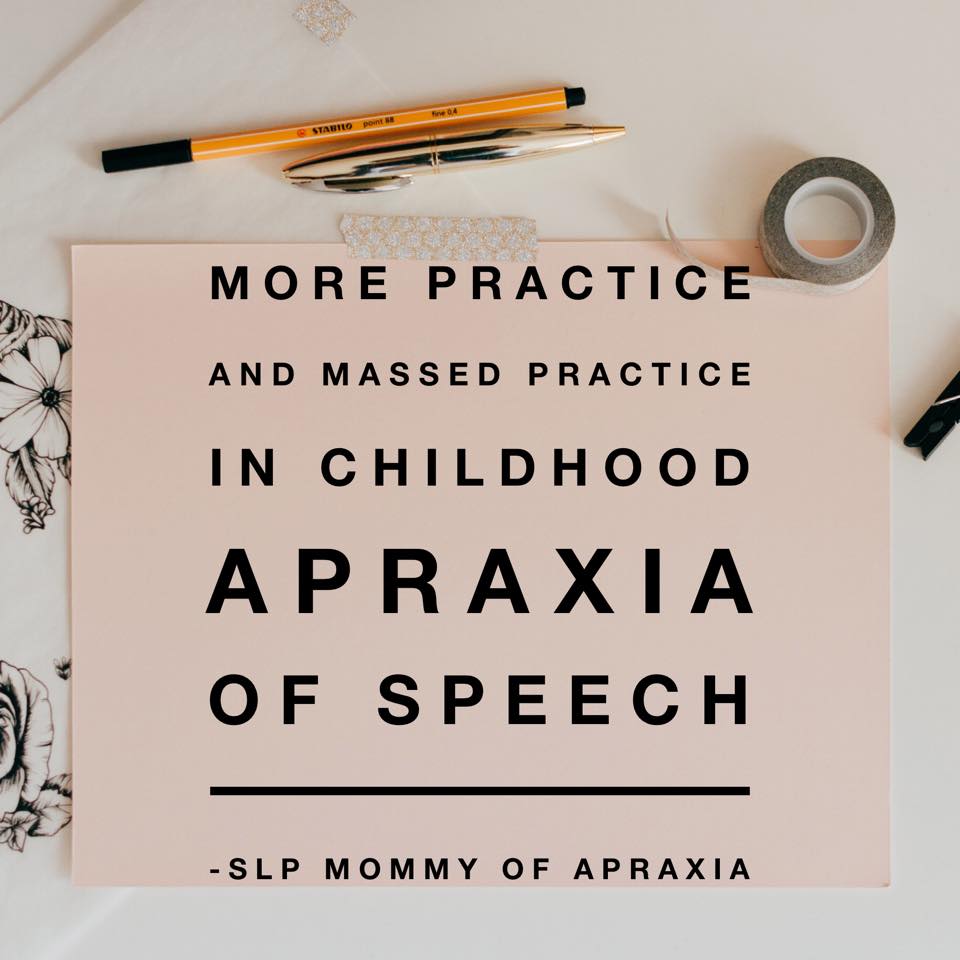Advantage for more practice and massed practice in CAS

A new study finds a marked advantage for more practice, as opposed to less practice, in the treatment of Childhood Apraxia of Speech and that there is support for massed practice of speech targets versus distributed practice.
August 2019
The primary purpose of the study by Maas and colleagues, detailed in the recent publication “Bang for Your Buck: A Single Case Experimental Design Study of Practice Amount and Distribution in Treatment for Childhood Apraxia of Speech” was to study treatment intensity in treatment for CAS. The specific aspects of intensity addressed in this study included both practice amount and practice distribution. Practice amount refers to the cumulative amount of practice trials and treatment sessions provided, while practice distribution relates to how the practice amounts are divided – or distributed- across the treatment period.
A secondary aim was to further examine the efficacy of a therapy approach called “integral stimulation” (in this article the form of integral stimulation is termed ASSIST. ASSIST stands for “Apraxia of Speech Systematic Integral Stimulation Treatment” and was specifically developed to facilitate replication, experimental control, and consistency in research studies using the approach.
Why did researchers study this?
Anecdotally, and in several small studies, children with apraxia of speech reportedly benefit in their speech improvement when speech therapy incorporates what are known as “principles of motor learning.” These principles are essentially several factors that have been demonstrated to facilitate the retention and transfer of motor skills. Principles of motor learning includes specific factors such as how someone practices a motor skill as well as the feedback they receive when they practice the skill. These “principles” of both practice and feedback influence the permanent retention of a motor skill, according to motor learning research.
In this study, researchers were focused on conditions of practice. Conditions of practice includes the intensity of practice, i.e. how much practice of the skill should occur and if that practice should occur in a “massed” way (a set amount of practice in a short period of time) or distributed way (a set amount of practice occurring over a longer period).
The diagnosis of Childhood Apraxia of Speech relates to a child’s ability, or lack of ability, to plan and program the series of highly specific movements that underlie intelligible speech. Researchers have wondered if aspects of how people learn and retain other movement and motor skills and achieve skilled movements could impact how children with apraxia of speech learn speech motor skills (i.e. the motor planning and programming that underlie speech).
However, principles of motor learning which originated through studying physical movements vs speech arose from motor learning research that is primarily based on studies of average adults, not on children, and not on children with speech motor problems like apraxia. Therefore, while motor learning principles provide a possible framework for how one might learn and retain the motor skills needed for speech, research using these principles, specifically on children with apraxia of speech, is needed.
Finally, the authors point out that results from motor learning research as it relates to intensity differ from results from another body of research in neuroplasticity. Specifically, motor learning research has found that distributed practice results in better outcomes than massed practice conditions. The reverse is true, however, in neuroplasticity research.
What did the researchers do?
Participants were a group of six children with CAS who were carefully chosen using well-defined criteria for inclusion in the study. Data was taken over approximately 24 weeks. The study design was described as an “alternating treatments design.” In this type of study design, all the participants receive all the experimental conditions in the full course of the study., All participants received massed and distributed practice. Additionally, depending on the practice distribution, the number of practice targets varied per session (allowing amount of practice to also be manipulated and examined).
What did they find out?
Regarding the amount of practice, the study results indicate that, four of the six children showed greater improvement and effect sizes with more practice of a smaller set of targets. Targets practiced with a low amount of practice were, overall, not different than the untreated targets. Both individual and group data suggests there is a greater advantage for more practice and supports the assertion and previous research that children with CAS benefit from more practice.
Regarding practice distribution, the study found that 5 out of the 6 participants most benefitted from massed versus distributed practice. As a group, there appears to be an advantage to massed practice as shown byeffect size and percent change. The researchers indicate that this finding is more aligned with neuroplasticity research than it is motor learning literature.
Finally, this study contributes to existing research demonstrating that the “integral stimulation” approach to speech therapy for children with CAS is an effective approach. Integral stimulation approaches include a focus on tactile cues, slowed rate, fading of cues over time, and a focus on movement accuracy of complete speech targets (vs. the segmentation of targets).
Summary
In this study, researchers found that children with apraxia of speech benefit from more speech practice opportunities, especially when the practice of the speech targets is massed, i.e. a set amount of practice that happens in a short period of time. Integral stimulation methods are an important tool in treatment for children with CAS.
Limitations of the current study include the small sample size and modest effect size, likely due to a relatively small amount of overall practice. More research is needed with larger sample sizes and greater differences between conditions.
Source:
Maas, Edwin, et al. “Bang for Your Buck: A Single-Case Experimental Design Study of Practice Amount and Distribution in Treatment for Childhood Apraxia of Speech.” Journal of Speech, Language, and Hearing Research (2019): 1-23.
https://pubs.asha.org/doi/10.1044/2019_JSLHR-S-18-0212
This article was written in collaboration with contributors to SLP Mommy of Apraxia.

Laura Smith, M.A. CCC-SLP is a 2014 graduate of Apraxia Kids Boot Camp, has completed the PROMPT Level 1 training, and the Kaufman Speech to Language Protocol (K-SLP). She has lectured throughout the United States on CAS and related issues. Laura is committed to raising and spreading CAS awareness following her own daughter’s diagnosis of CAS and dyspraxia. She is the apraxia walk coordinator for Denver, and writes for various publications including the ASHA wire blog, The Mighty, and on a website she manages slpmommyofapraxia.com. In 2016, Laura was awarded ASHA’s media award for garnering national media attention around apraxia detailing her encounter with UFC fighter Ronda Rousey, and also received ASHA’s ACE award for her continuing education, specifically in the area of childhood motor speech disorders. Currently, Laura is a practicing SLP specializing in apraxia at her clinic A Mile High Speech Therapy in Aurora, Colorado.